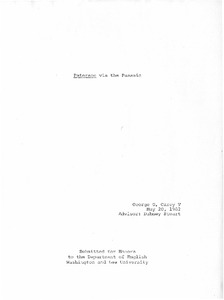| dc.rights.license | In Copyright | en_US |
| dc.creator | Carey, George Gibson, V | |
| dc.date.accessioned | 2023-10-20T15:49:46Z | |
| dc.date.available | 2023-10-20T15:49:46Z | |
| dc.date.created | 1982 | |
| dc.identifier | WLURG038_Carey_thesis_1982 | |
| dc.identifier.uri | https://dspace.wlu.edu/handle/11021/36305 | |
| dc.description.abstract | Paterson does and says many different things but its most central concern is man and his relationship to the world. Williams adamantly believes that a sustained, immediate interpenetration between the individual and his physical environrnent is essential, and is continually at war with the individual's impulse to deal with abstract, indefinite matters of mortality and spiritual truth.
Given the state of unending flux that continually occurs within both the mind and its physical environment, the individual must continually reexamine, reaffirm, and rework all that he has thought, spoken, and written if Williams' interpenetration is to be sustained. Ideally, such continual remeasuring of the old culminates in a life of refreshing change free of monotony and stagnation. As a means of illustrating the benefits and joys inherent in such an existence, and some of the problems and difficulties associated with its attainment, Paterson has as its main character Paterson, a young, inexperienced poet who is struggling to overcome the suffocating burdens of tradition which threaten to cut him off from the true source of his art, the irnrned{ate world. His quest takes place throughout the first four books of the poem beginning with an examination of the "elemental character" of Paterson's environment, Paterson, New Jersey. By selecting identical naines for the man and the city he wanders in and around, the similarities in their complexity, diversity, and individuality are made particularly apparent. In anything but a clear narrative voice, the poem continues by describing the poet's numerous trials, failures and eventual success in developing a language that "breaks through the deadness of copied forms which keep shouting above everything that wants to get said today, drowning the man with the accumulated weight of a thousand voices in the past." (1) The fourth book concludes Paterson's struggle for enlightenment with his gaining a new understanding of the full creative process, the final element needed to make his revolutionary language vocal and sustained. [From Introduction] | en_US |
| dc.format.extent | 62 pages | en_US |
| dc.language.iso | en_US | en_US |
| dc.rights | This material is made available for use in research, teaching, and private study, pursuant to U.S. Copyright law. The user assumes full responsibility for any use of the materials, including but not limited to, infringement of copyright and publication rights of reproduced materials. Any materials used should be fully credited with the source. | en_US |
| dc.rights.uri | http://rightsstatements.org/vocab/InC/1.0/ | en_US |
| dc.subject.other | Washington and Lee University -- Honors in English | en_US |
| dc.title | Paterson via the Passaic | en_US |
| dc.type | Text | en_US |
| dcterms.isPartOf | WLURG038 - Student Papers | en_US |
| dc.rights.holder | Carey, George Gibson, V | en_US |
| dc.subject.fast | New Jersey -- Paterson -- Poetry | en_US |
| dc.subject.fast | New Jersey -- Passaic River -- Poetry | en_US |
| dc.subject.fast | Williams, William Carlos, 1883-1963 | en_US |
| local.department | English | en_US |
